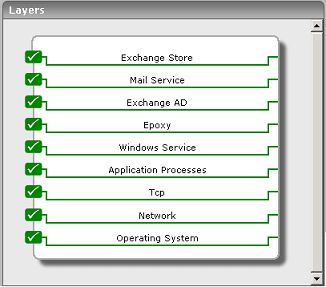Monitoring Exchange 2000/2003 Servers
eG Enterprise's unique layer model representation (see Figure 1) provides an intuitive and elegant way to correlate the application performance with network, CPU, memory, and disk performance, thereby allowing administrators to quickly interpret where the performance bottlenecks may be.

Figure 1 : Layer model of an Exchange 2000/2003 server
Data collected by the eG agents is stored in a relational database, so historical analysis and diagnosis can be performed to determine how the server can be reconfigured for optimal performance. The key performance-related questions that the data so collected helps answer, are listed in the table below.
|
Service Monitoring |
|
|
Process Monitoring |
|
|
Mail Traffic Monitoring |
|
|
Network Monitoring |
|
|
Memory Monitoring |
|
|
Disk Monitoring |
|
|
CPU Monitoring |
|
|
Active Directory Monitoring |
|
The sections to come describe each layer of Figure 1.
